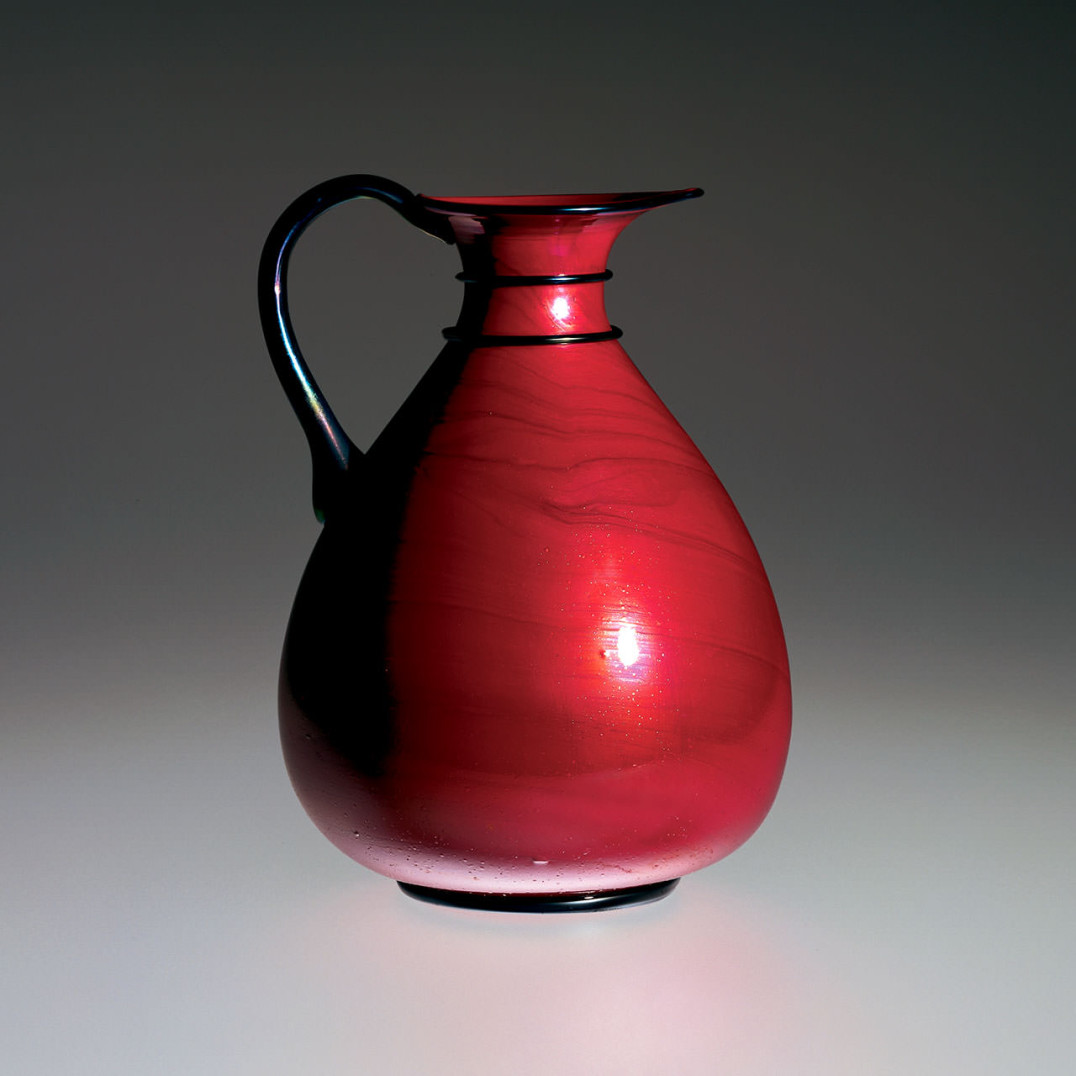
Carlo ScarpaPasta vitrea, 1930
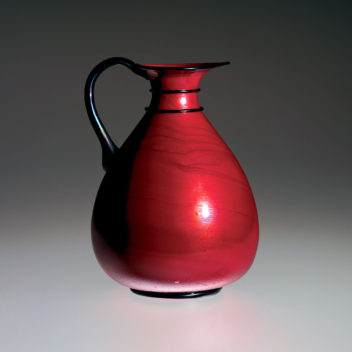
Carlo ScarpaPasta vitreaMaestri Vetrai Muranesi Cappellin & C., 1930
Red iridized pasta vitrea pitcher with a large handle and trim in black pasta vitrea.
Acid stamped: M.V.M. Cappellin Murano.
9 5/8 in. high (24.5 cm)
Exhibitions:
1929, Paris, Salon d’Automne;
1930, Monza, 4th Esposizione delle Arti Decorative e Industriali Moderne; 1931, Amsterdam, Exhibition of modern Italian glass, ceramic, and artistic lacework, Stedelijk Museum;
1964, Venice, 32nd Biennale Internazionale d’Arte, Exhibition of
the Decorative Arts of the Venetian Territory; 2000, New York, Venetian Glass, Museum of Arts & Design;
2001, Milan, Murano: Vetri dalla Collezione Olnick Spanu, Spazio Oberdan.
Bibliography and comparative texts:
M.V.M. Catalogue, n. 5536; Domus, 1930, January p. 38; Mostra di vetri…, 1931, pp. 22, 23; Venezianisches Glas…, 1981, p. 64; Murano Glass…, 1982, n. 122; Mostra del vetro…, 1984, p. 83;
M. Karasik, 1989, n. 4;
M. Barovier, 1991, nn. 1, 2;
M. Barovier, 1997, p. 194;
M. Barovier, 1998 (b), pp. 7, 8, 9;
M. Barovier, 1999, p. 141;
Olnick Spanu, 2000, n. 22;
Olnick Spanu, 2001, n. 34.
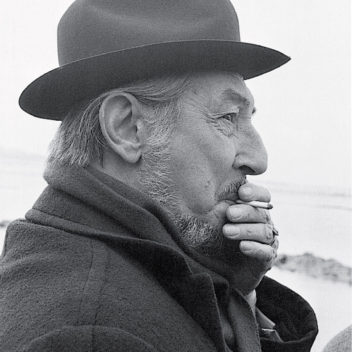
Carlo Scarpa 1906–1978
Born in Venice, Carlo Scarpa graduated from the Accademia di Belle Arti in Venice in 1926. Soon after his graduation he began work at M.V.M. Cappellin, where he soon replaced Vittorio Zecchin as artistic director. Following the direction laid down by Zecchin, he initially created transparent blown-glass pieces with essential forms, in particular the pieces exemplified by their conic base. Scarpa later designed light glass pieces in brightly colored pasta vitrea, or decorated fenici. Deservedly famous was the refined collection of lattimi decorated with gold or silver leaf, which he presented for the first time in Monza in 1930 together with the canne verticali and millefiori glass works. Giacomo Cappellin closed the workshop in 1932 for bankruptcy, putting an end to the collaboration with Carlo Scarpa. In 1934, Scarpa became the artistic director of Venini & C., where he continued to work through 1947. Alongside Paolo Venini, who often participated in the design of glass, Carlo Scarpa experimented with the vast potential of glass, using and innovating many traditional techniques, by which he created extraordinary modern pieces. After the mezza filigrana glass works came the sommersi, the pasta vitrea inspired by Chinese ceramic motifs, the corrosi, the battuti, the vessels a fasce colorate, a pennellate, the variegati, and the famous multicolored murrine with the surfaces finished at the carving wheel. After World War II, Carlo Scarpa worked almost exclusively as an architect and teacher.
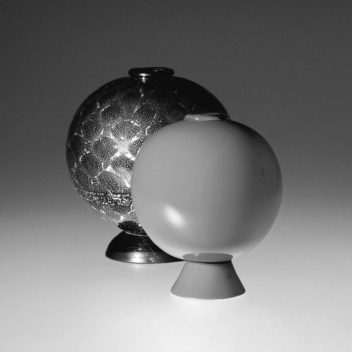
Maestri Vetrai Muranesi Cappellin & C. 1925–1932
M.V.M. Cappellin & C. was founded in 1925 by Giacomo Cappellin after the closing of Cappellin Venini & C. Vittorio Zecchin, a painter from Murano who had worked for Cappellin Venini, continued his collaboration with Cappellin for a short time, designing soffiati, blown glass pieces characterized by delicate colors and pure lines. At the end of 1926, following Zecchin's departure, the young Carlo Scarpa took over the artistic direction of the company. Initially, he proceeded along the course taken by his predecessor, creating lightweight blown pieces with simple geometric forms. These were followed by many collections of refined elegance characterized by various transparent textures and often distinguished by vivid colors. Despite the remarkable success at the 1930 Biennale di Monza, M.V.M. Cappellin & C. was forced to close in January 1932. This was most likely the result of inefficient financial management.
Carlo ScarpaPasta vitrea, 1930
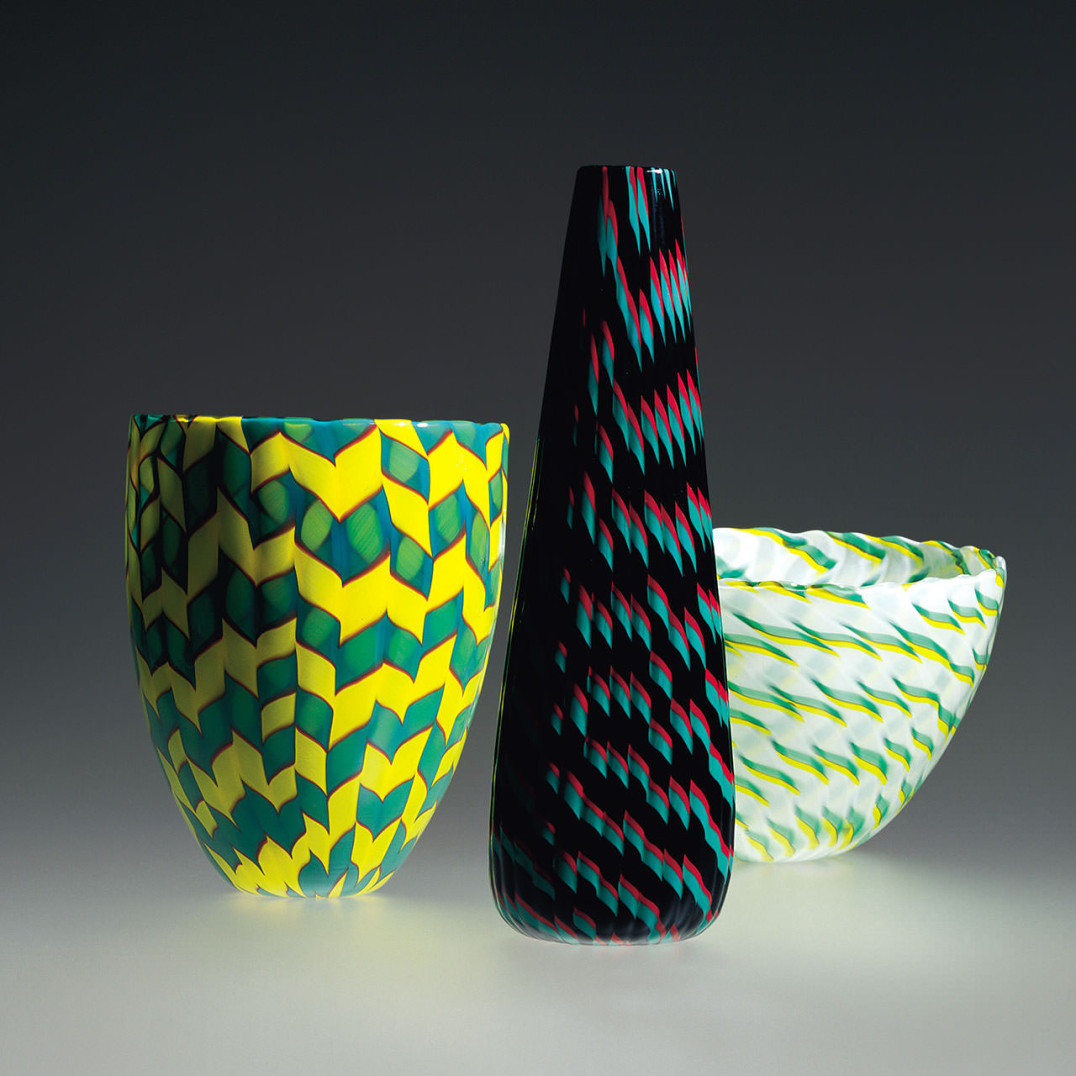
James CarpenterCalabash, 1980
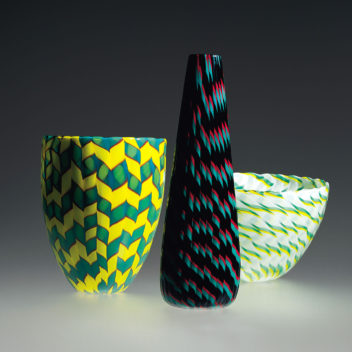
James CarpenterCalabashVenini & C., 1980
Three opaque glass vessels.
The one on the left is yellow with a jagged green and blue pattern outlined in red; the one in the middle is black with turquoise and red; the bowl on the right is white with green and yellow glass.
Engraved: venini italia.
8 1/4 in. high (21 cm)
12 1/4 in. high (31.1 cm)
5 9/16 in. high (14.2 cm)
Exhibitions:
2000, New York, Venetian Glass, Museum of Arts & Design;
2001, Milan, Murano: Vetri dalla Collezione Olnick Spanu, Spazio Oberdan.
Bibliography and comparative texts:
Murano oggi…, 1981, nn. 331-332;
G. Duplani Tucci, 1989, p. 93;
A. Venini Diaz de Santillana, 1996, n. 251; M. Barovier, 1999, p. 319;
A. Venini Diaz de Santillana, 2000, n. 254;
Olnick Spanu, 2000, n. 149;
Olnick Spanu, 2001, n. 187.

James Carpenter 1949–
Born in Washington, DC, James Carpenter graduated in 1972 from the Rhode Island School of Design with a B.F.A. in Sculpture. After his first collaboration at Venini, from October 1971 to May 1972, Carpenter returned several times to participate in the design of various glassworks. During this time, he worked along with Ludovico Diaz de Santillana, experimenting in new techniques for the creation of large multicolored glass windows. His designs were included in the exhibition of historical and contemporary Venini glass held in New York in 1984. Among the works he designed for Venini is the Calabash, executed with the use of multicolored glass rods. For more than twenty-five years, Carpenter's work has focused on the exploration of light as a means to bring form to structure and reveal the environment. As an artist considered to be a foremost innovator in materials technologies, Carpenter has worked collaboratively with major architects in the United States and abroad on significant building projects and has received many major architectural and public art commissions. Carpenter currently works in New York.

Venini & C. 1932–2001
In 1932, when both Martinuzzi and Zecchin left the company, Paolo Venini changed the name from Vetri Soffiati Muranesi Venini & Co. (V.S.M. Venini & Co.) to Venini & C.. Milanese architect Tommaso Buzzi became the new artistic director. After 1934, artistic direction was taken on by Carlo Scarpa, who designed most of the company's production through 1947. Side by side with Venini, who often intervened personally in design, Scarpa created numerous collections of objects characterized by refined colors. After World War II, Venini & C. sought numerous collaborations with artists such as architect Giò Ponti and the Swedish-born Tyra Lundgren. After 1948, Fulvio Bianconi, Massimo Vignelli, and Tobia Scarpa contributed significantly to the new direction of the company. Paolo Venini died in 1959 and his son-in-law, Ludovico Diaz de Santillana, took over the management of Venini & C. He not only worked personally as a glass designer but also continued the collaboration started by Paolo Venini with various artists and designers. Starting in 1960, many other designers collaborated with the company, like Thomas Stearns, Toni Zuccheri, Tapio Wirkkala, Laura and Alessandro Diaz de Santillana, James Carpenter, Dan Dailey, Richard Marquis, Benjamin Moore, and Toots Zynsky. In 1986, the de Santillana family left the company, selling their stock to the Ferruzzi group, which guaranteed the fine quality Venini was known for by hiring new designers such as Timo Sarpaneva, Marco Zanini, Ettore Sottsass Jr., Alessandro Mendini, Mario Bellini, Barbara del Vicario, and others. In 1988, Venini was acquired by Royal Scandinavian. Since 2001, Venini S.p.A. has been part of Italian Luxury Industries Group and is led by Giancarlo Chimento, Giuliano Tabacchi, and Giorgio Rizzo.
James CarpenterCalabash, 1980

Carlo ScarpaPasta vitrea, 1929-1930
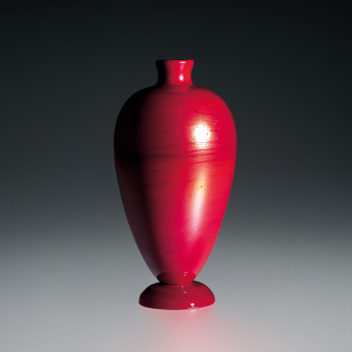
Carlo ScarpaPasta vitreaMaestri Vetrai Muranesi Cappellin & C., 1929-1930
A red pasta vitrea vase with applied foot.
Acid stamped: M.V.M. Cappellin Murano.
8 1/4 in. high (21 cm)
Exhibitions:
1929, Paris, Salon d’Automne;
1930, Monza, 4th Esposizione delle Arti Decorative e Industriali Moderne;
1931, Amsterdam, Exhibition of modern Italian glass, ceramic, and artistic lacework, Stedelijk Museum;
1964, Venice, 32nd Biennale Internazionale d’Arte, Exhibition of the Decorative Arts of the Venetian Territory; 2000, New York, Venetian Glass, Museum of Arts & Design;
2001, Milan, Murano: Vetri dalla Collezione Olnick Spanu, Spazio Oberdan.
Bibliography and comparative texts:
M.V.M. Catalogue, n. 5911; Domus, 1930, January p. 38; Mostra di vetri…, 1931, pp. 22, 23; Venezianisches Glas…, 1981, p. 64; Murano Glass…, 1982, n. 122; Mostra del vetro…, 1984, p. 83;
M. Karasik, 1989, n. 4; M. Barovier, 1991, nn. 1, 2; M. Barovier, 1997, p. 194;
M. Barovier, 1998(b), pp. 7, 8, 9;
M. Barovier, 1999, p. 141;
Olnick Spanu, 2000, n. 21;
Olnick Spanu, 2001, n. 35.

Carlo Scarpa 1906–1978
Born in Venice, Carlo Scarpa graduated from the Accademia di Belle Arti in Venice in 1926. Soon after his graduation he began work at M.V.M. Cappellin, where he soon replaced Vittorio Zecchin as artistic director. Following the direction laid down by Zecchin, he initially created transparent blown-glass pieces with essential forms, in particular the pieces exemplified by their conic base. Scarpa later designed light glass pieces in brightly colored pasta vitrea, or decorated fenici. Deservedly famous was the refined collection of lattimi decorated with gold or silver leaf, which he presented for the first time in Monza in 1930 together with the canne verticali and millefiori glass works. Giacomo Cappellin closed the workshop in 1932 for bankruptcy, putting an end to the collaboration with Carlo Scarpa. In 1934, Scarpa became the artistic director of Venini & C., where he continued to work through 1947. Alongside Paolo Venini, who often participated in the design of glass, Carlo Scarpa experimented with the vast potential of glass, using and innovating many traditional techniques, by which he created extraordinary modern pieces. After the mezza filigrana glass works came the sommersi, the pasta vitrea inspired by Chinese ceramic motifs, the corrosi, the battuti, the vessels a fasce colorate, a pennellate, the variegati, and the famous multicolored murrine with the surfaces finished at the carving wheel. After World War II, Carlo Scarpa worked almost exclusively as an architect and teacher.

Maestri Vetrai Muranesi Cappellin & C. 1925–1932
M.V.M. Cappellin & C. was founded in 1925 by Giacomo Cappellin after the closing of Cappellin Venini & C. Vittorio Zecchin, a painter from Murano who had worked for Cappellin Venini, continued his collaboration with Cappellin for a short time, designing soffiati, blown glass pieces characterized by delicate colors and pure lines. At the end of 1926, following Zecchin's departure, the young Carlo Scarpa took over the artistic direction of the company. Initially, he proceeded along the course taken by his predecessor, creating lightweight blown pieces with simple geometric forms. These were followed by many collections of refined elegance characterized by various transparent textures and often distinguished by vivid colors. Despite the remarkable success at the 1930 Biennale di Monza, M.V.M. Cappellin & C. was forced to close in January 1932. This was most likely the result of inefficient financial management.
Carlo ScarpaPasta vitrea, 1929-1930
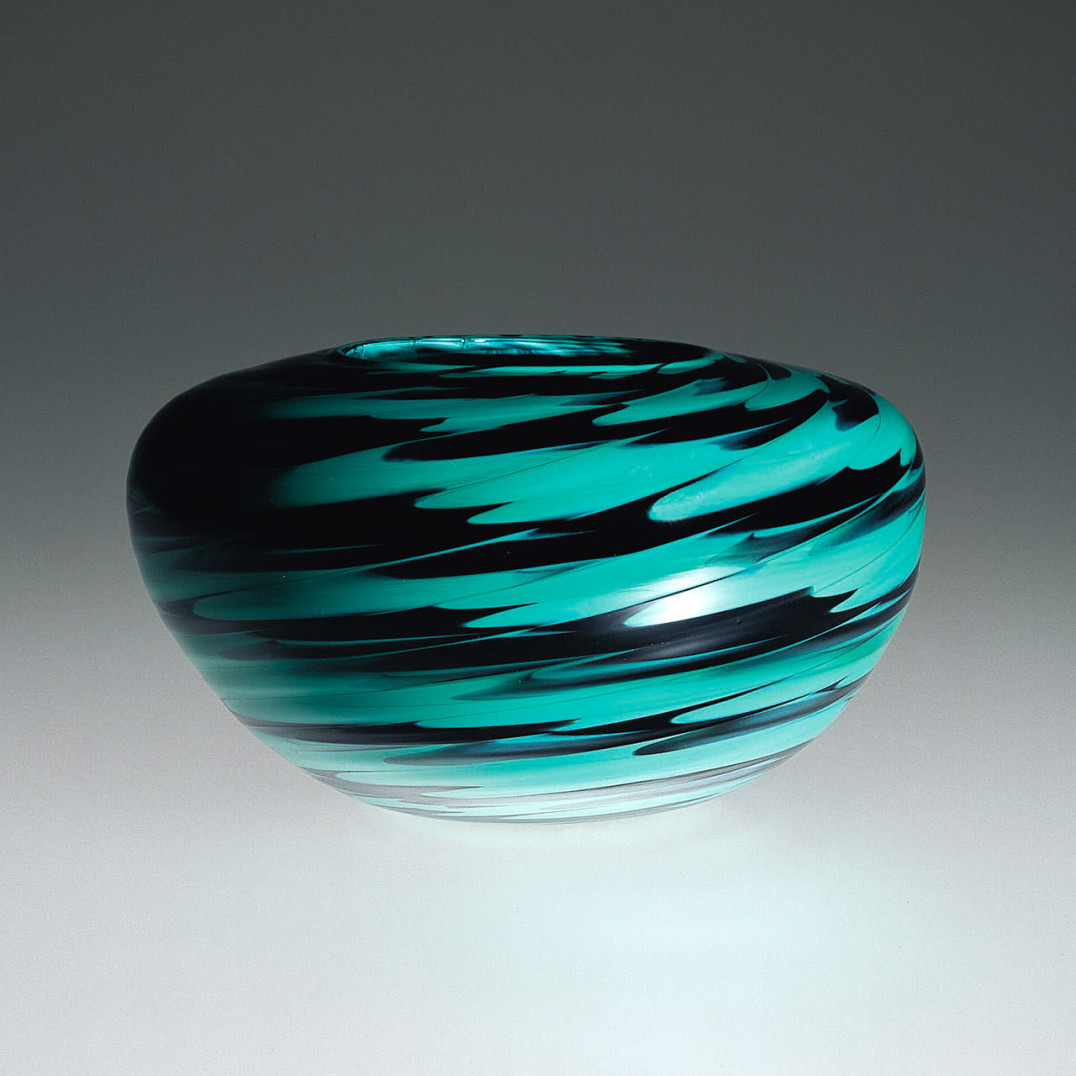
James CarpenterPrototipo, ca. 1979
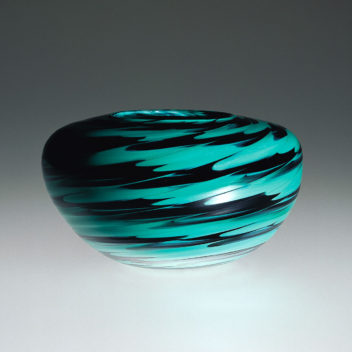
James CarpenterPrototipoVenini & C., ca. 1979
A prototype vessel composed of spiraling horizontal ritorte (canes)
in turquoise green and black.
Engraved: Carpenter, Venini.
4 3/4 in. high (12.1 cm)
Exhibitions:
2000, New York, Venetian Glass, Museum of Arts & Design;
2001, Milan, Murano: Vetri dalla Collezione Olnick Spanu, Spazio Oberdan.
Bibliography and comparative texts:
M. Barovier, 1999, p. 288;
Olnick Spanu, 2000, n. 148;
Olnick Spanu, 2001, n. 186.

James Carpenter 1949–
Born in Washington, DC, James Carpenter graduated in 1972 from the Rhode Island School of Design with a B.F.A. in Sculpture. After his first collaboration at Venini, from October 1971 to May 1972, Carpenter returned several times to participate in the design of various glassworks. During this time, he worked along with Ludovico Diaz de Santillana, experimenting in new techniques for the creation of large multicolored glass windows. His designs were included in the exhibition of historical and contemporary Venini glass held in New York in 1984. Among the works he designed for Venini is the Calabash, executed with the use of multicolored glass rods. For more than twenty-five years, Carpenter's work has focused on the exploration of light as a means to bring form to structure and reveal the environment. As an artist considered to be a foremost innovator in materials technologies, Carpenter has worked collaboratively with major architects in the United States and abroad on significant building projects and has received many major architectural and public art commissions. Carpenter currently works in New York.

Venini & C. 1932–2001
In 1932, when both Martinuzzi and Zecchin left the company, Paolo Venini changed the name from Vetri Soffiati Muranesi Venini & Co. (V.S.M. Venini & Co.) to Venini & C.. Milanese architect Tommaso Buzzi became the new artistic director. After 1934, artistic direction was taken on by Carlo Scarpa, who designed most of the company's production through 1947. Side by side with Venini, who often intervened personally in design, Scarpa created numerous collections of objects characterized by refined colors. After World War II, Venini & C. sought numerous collaborations with artists such as architect Giò Ponti and the Swedish-born Tyra Lundgren. After 1948, Fulvio Bianconi, Massimo Vignelli, and Tobia Scarpa contributed significantly to the new direction of the company. Paolo Venini died in 1959 and his son-in-law, Ludovico Diaz de Santillana, took over the management of Venini & C. He not only worked personally as a glass designer but also continued the collaboration started by Paolo Venini with various artists and designers. Starting in 1960, many other designers collaborated with the company, like Thomas Stearns, Toni Zuccheri, Tapio Wirkkala, Laura and Alessandro Diaz de Santillana, James Carpenter, Dan Dailey, Richard Marquis, Benjamin Moore, and Toots Zynsky. In 1986, the de Santillana family left the company, selling their stock to the Ferruzzi group, which guaranteed the fine quality Venini was known for by hiring new designers such as Timo Sarpaneva, Marco Zanini, Ettore Sottsass Jr., Alessandro Mendini, Mario Bellini, Barbara del Vicario, and others. In 1988, Venini was acquired by Royal Scandinavian. Since 2001, Venini S.p.A. has been part of Italian Luxury Industries Group and is led by Giancarlo Chimento, Giuliano Tabacchi, and Giorgio Rizzo.
James CarpenterPrototipo, ca. 1979
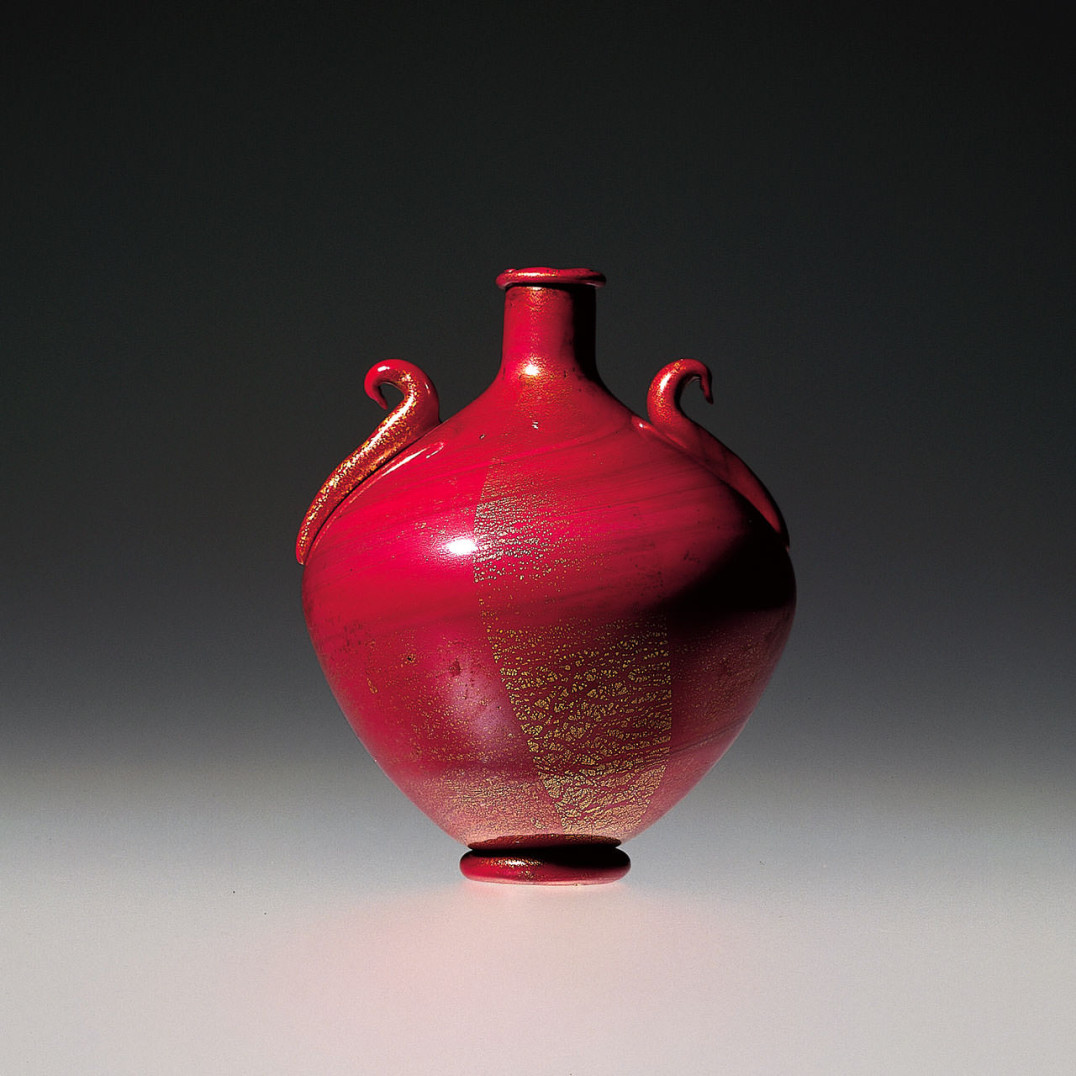
Carlo ScarpaPasta vitrea, 1929-1930
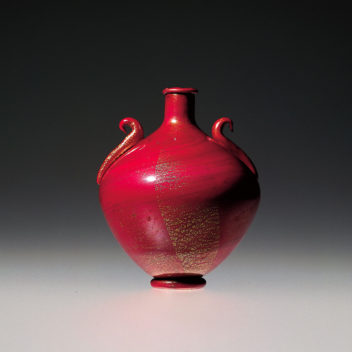
Carlo ScarpaPasta vitreaMaestri Vetrai Muranesi Cappellin & C., 1929-1930
Red pasta vitrea vase with two side handles, decorated throughout with gold leaf.
5 7/8 in. high (15 cm)
Exhibitions:
1929, Paris, Salon d’Automne;
1930, Monza, 4th Esposizione delle Arti Decorative e Industriali Moderne;
1931, Amsterdam, Exhibition of modern Italian glass, ceramic, and artistic lacework, Stedelijk Museum;
1964, Venice, 32nd Biennale Internazionale d’Arte, Exhibition of
the Decorative Arts of the Venetian Territory;
2000, New York, Venetian Glass, Museum of Arts & Design;
2001, Milan, Murano: Vetri dalla Collezione Olnick Spanu, Spazio Oberdan.
Bibliography and comparative texts:
M.V.M. Catalogue, n. 5911; Domus, 1930, January, p. 38; Mostra di vetri…, 1931, pp. 22, 23; Venezianisches Glas…, 1981, p. 64; Murano Glass…, 1982, n. 122; Mostra del Vetro…, 1984, p. 83;
W. Warmus, 1989, n. 4;
M. Barovier, 1991, n. 1, 2;
M. Barovier, 1997, p. 194;
M. Barovier, 1998 (b), pp. 7, 8, 9;
M. Barovier, 1999, p. 141;
Olnick Spanu, 2000, n. 19;
Olnick Spanu, 2001, n. 36.

Carlo Scarpa 1906–1978
Born in Venice, Carlo Scarpa graduated from the Accademia di Belle Arti in Venice in 1926. Soon after his graduation he began work at M.V.M. Cappellin, where he soon replaced Vittorio Zecchin as artistic director. Following the direction laid down by Zecchin, he initially created transparent blown-glass pieces with essential forms, in particular the pieces exemplified by their conic base. Scarpa later designed light glass pieces in brightly colored pasta vitrea, or decorated fenici. Deservedly famous was the refined collection of lattimi decorated with gold or silver leaf, which he presented for the first time in Monza in 1930 together with the canne verticali and millefiori glass works. Giacomo Cappellin closed the workshop in 1932 for bankruptcy, putting an end to the collaboration with Carlo Scarpa. In 1934, Scarpa became the artistic director of Venini & C., where he continued to work through 1947. Alongside Paolo Venini, who often participated in the design of glass, Carlo Scarpa experimented with the vast potential of glass, using and innovating many traditional techniques, by which he created extraordinary modern pieces. After the mezza filigrana glass works came the sommersi, the pasta vitrea inspired by Chinese ceramic motifs, the corrosi, the battuti, the vessels a fasce colorate, a pennellate, the variegati, and the famous multicolored murrine with the surfaces finished at the carving wheel. After World War II, Carlo Scarpa worked almost exclusively as an architect and teacher.

Maestri Vetrai Muranesi Cappellin & C. 1925–1932
M.V.M. Cappellin & C. was founded in 1925 by Giacomo Cappellin after the closing of Cappellin Venini & C. Vittorio Zecchin, a painter from Murano who had worked for Cappellin Venini, continued his collaboration with Cappellin for a short time, designing soffiati, blown glass pieces characterized by delicate colors and pure lines. At the end of 1926, following Zecchin's departure, the young Carlo Scarpa took over the artistic direction of the company. Initially, he proceeded along the course taken by his predecessor, creating lightweight blown pieces with simple geometric forms. These were followed by many collections of refined elegance characterized by various transparent textures and often distinguished by vivid colors. Despite the remarkable success at the 1930 Biennale di Monza, M.V.M. Cappellin & C. was forced to close in January 1932. This was most likely the result of inefficient financial management.